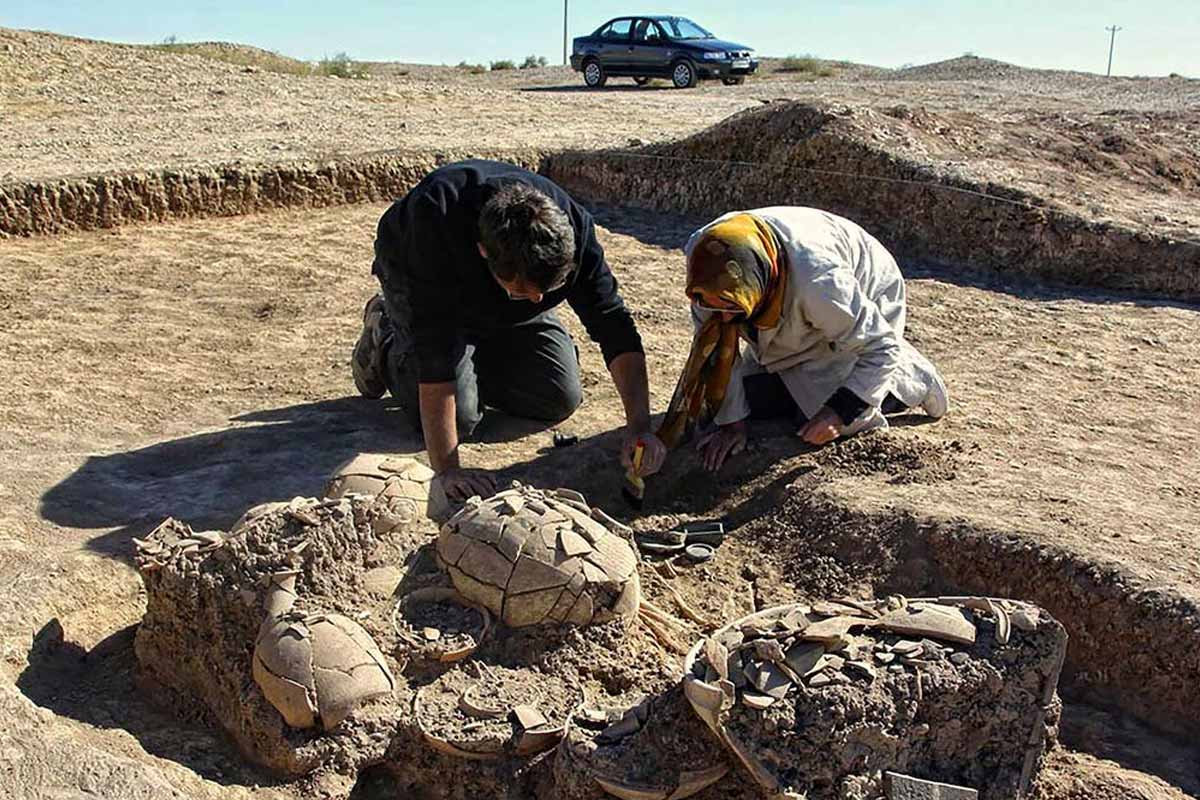Gold glints beside carved stone, while tiny seals whisper of rank and reach. At Tepe Chalow in northeastern Iran, a teenage girl rests in a richly furnished tomb. Archaeologists call it Grave 12, and its careful layout frames status, craft, and exchange. The burial dates to the early second millennium BCE, yet its order feels deliberate today. Each object seems placed with purpose, and every detail points toward a life tied to power.
Grave 12 at Tepe Chalow and the tomb context
Grave 12 is the richest burial yet found at Tepe Chalow. Excavators recorded thirty-four objects, from jewelry to carved stones and fine pottery. Gold rings and earrings sit with bronze ornaments, while two ivory pins mark skilled makers. The assemblage reflects careful selection, steady access, and deliberate choices.
A chlorite cosmetic container shows snakes and scorpions in low relief, a motif across eastern Iran. A small seal near the neck depicts two feet with a circle and semicircle inside a frame. This tomb anchors that point. These images likely encoded identity, office, or access within local networks.
The body lay crouched on the right side, hands near the face, facing southeast. Pottery vessels stood behind the back, above the head, and below the feet in order. This pattern repeats across the cemetery, which suggests shared rules for arranging people, objects, and meanings for mourners.
Seals as working signatures in Bronze Age exchange
Seals worked like signatures on containers, storerooms, and shipments in Bronze Age settings each day. Pressed into wet clay, they fixed names, offices, or institutions to goods already moving between hands. Their marks traveled with jars and bundles, so accountability remained visible across checkpoints, ledgers, and guarded doors.
Several seals in one burial imply more than family wealth or display. They signal participation in handling goods and managing property within ordered spaces; this tomb anchors that point for readers. In many ancient contexts, such clusters gravitate toward people who supervised storage or measured rations with oversight.
That pattern fits Chalow’s evidence, which pairs seals with elite items and careful placements. A large vessel at the feet often held special objects, including metal containers and marked stones with images. Such packages suggest procedures, because containers, tools, and marks reinforce stable administrative behavior over time.
Status, family plots, and the logic of elite burial
The person in Grave 12 died before adulthood, yet the goods suggest high standing and reach and duty. Status likely moved through families, households, or ties to administrators and makers within the region. Clustered graves hint at family plots, where space and objects signal membership, memory, and privilege.
Gold, carved stone, and elaborate pins do more than sparkle under trench light. They reveal access to skilled workshops and distant materials through sustained exchange. This tomb anchors that point. Even a smaller settlement could command resources beyond nearby fields when networks stayed active and coordinated over time.
Consistent placement also matters, since order trains memory and marks belonging for participants. The crouched posture, the repeated vessel positions, and the framed seal at the neck align clearly. Together they communicate role, expectation, and care within a community that watched responsibilities closely for watchers and mourners.
Chalow within BMAC routes and long-distance materials
Tepe Chalow sits within the Bactria-Margiana Archaeological Complex, also called Greater Khorasan. This horizon reached from the Murghab delta into northeastern Iran and nearby routes. Its settlements spread along water, which linked oases and valleys. A joint Iranian-Italian campaign reported the cemetery’s BMAC materials after the 2011 season.
Trade moved stones and metals along these corridors in the third and second millennia BCE. Mesopotamian records and finds show imports like lapis lazuli from Afghanistan and eastern Iranian chlorite. These flows placed the Iranian Plateau at a crossroads, where travelers joined multiple cultural spheres. This tomb anchors that point.
Centuries later, parts of these routes merged into what historians call the Silk Roads. The named network came much later, yet the older paths prepared movement, habit, and trust. Chalow’s evidence anchors these earlier links and gives the region sharper historical texture and depth for merchants and officials.
Analyses that will refine the story of the tomb
Radiocarbon from a nearby grave runs between 2310 and 2130 BCE. The dates align with the window for Grave 12 and secure the cemetery’s chronology, as reported by the team. The study was led by Ali A. Vahdati, Iranian Ministry of Cultural Heritage, Tourism and Handicrafts, Bojnord, with European partners.
Next steps target metals, ceramics, and seals for close comparison and sourcing. Alloy recipes can expose workshop habits, while petrography and geochemistry trace stone and clay. This tomb anchors that point. Isotopes from humans or animals, when preserved, can test diet and movement across landscapes with care.
Combined with typologies of seals and styles of pottery, those measures tighten social pictures and roles. We learn who moved goods, who stored them, and who signed for passage across space. Tepe Chalow then becomes a working dossier, because procedures appear in objects, placements, and habits over time.
What this luxurious burial reveals about power and exchange
This grave shows a young life tied to authority, craft, and organized exchange, within one tomb. Objects tell a disciplined story, while seals attach people to procedures and movement. Placed with care, they bind status to labor and trust, so power appears practical, not only decorative. Chronology, materials, and imagery now converge, and they reveal networks behind the shine. Through them, a community’s rules remain visible, even when the person is silent.
